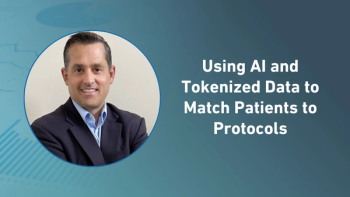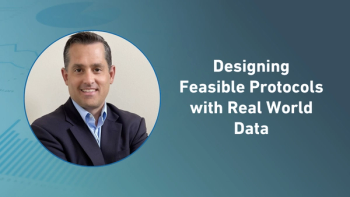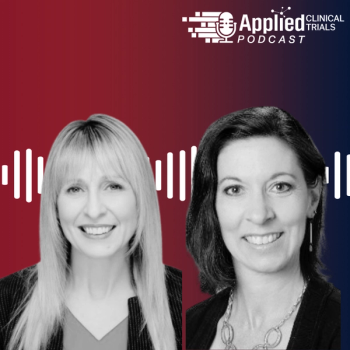
- Applied Clinical Trials-08-01-2021
- Volume 30
- Issue 7/8
Innovations in Data Capture Transforming Trial Delivery
Advances in technology open door for improved EHR to EDC transfer process.
Since the turn of the century, the pharmaceutical industry has actively supported the steady increase in the use of digital health technologies, including the important transition from paper-based health records to electronic health record systems (EHRs). An increasing proportion of health data is now digital (known from a regulatory perspective as eSource), bringing benefits to patients and clinicians alike.
While these advances in healthcare data have been mirrored in clinical trial settings, healthcare and clinical research activities remain, overwhelmingly, in separate worlds. Estimates are that 70%1 of clinical trial data is duplicated between electronic data capture (EDC) systems used for clinical trials and EHRs. The current methods for transferring this data continue to be manual, open to transcription errors, hugely wasteful and, ultimately, severely restricting to our ability to trial and launch potentially life-saving treatments for patients.
As an illustrative example, in a typical late Phase II/Phase III oncology trial encompassing around 200 patients, an average of 3.5 million data points will be entered into the EDC. Current methods involve a manual re-keying of a large proportion of this data from the EHR to the EDC, copying from screen to screen. This is followed by a manual data quality check known as source data validation (SDV), where it is not unusual for the clinical research associate (CRA) to also be accompanied by a hospital study coordinator. At each stage, time, effort, and costs multiply. In fact, around 20% of the total costs of a study (which can translate to between $16M-$24M2) is allocated to duplicating and verifying data.
The potential for a different approach—EHR2EDC
The idea that the current approach is less than optimal is not a new one. Attempts have been made to achieve an electronic transfer of data from EHR to EDC systems going back up to 30 years. However, previous efforts have been highly localized, bespoke solutions that only work between specific (often in-house) systems, and so have not realized the benefits we need at scale.
Now, with a growing network of eSource-ready hospitals, advances in technology, and a growing imperative due to the increasing complexity and cost of clinical trials, a tipping point has been reached. High quality, structured data is now available; connectivity has seen huge improvements; and adoption of systems designed for interoperability is fast becoming the norm. Achieving a seamless transfer of data from EHR to EDC is now not only possible, but essential.
As Table 1 shows below, the cost savings that could be achieved in a typical oncology trial by using an automated transfer of data from EHR to EDC (referred to as EHR2EDC) in place of the current manual re-keying and verification, could result in a cost saving of $15,000 per patient.
We must also consider the time saving benefits–a staggering 87,500 hours in our average 3.5 million data point study—in a climate where every day that a drug is delayed from market, sponsors lose up to $8 million3, but also delays patient access to a potentially valuable new treatment.
The journey so far
Over the last decade the stage has been set for EHR2EDC. A potted history of some of the work in this space includes:
- The Electronic Health Records Systems for Clinical Research (EHR4CR) project ran from 2011-16. Under the umbrella of Innovative Medicines Initiative (IMI), this project involved numerous research institutions and companies including AstraZeneca, GlaxoSmithKline, Merck and Sanofi.4 It established an ethically acceptable mechanism to tap into the emerging opportunity from the digitization of patient records for clinical study design and recruitment. The result was a technical proof of concept implementation and a governance framework for remotely and securely querying EHRs to validate protocols and select the best study sites. The project found that estimated efficiency gains through accelerating the time to market for a typical Phase II or III oncology trial could translate to benefits for the global pharmaceutical oncology sector of between $54.2 million and $2516.8 million (depending on level of application).5
- In 2016 The European Institute for Innovation through Health Data (i~HD) was formed to promote, develop and share good practices and tools, and leverage multi-stakeholder cooperation in the trustworthy use of high-quality health data. i~HD provides training, education and certification programs to ensure the quality and good governance of organizations handling health data.6
- In 2017 concerted efforts began to move on from clinical trial design and recruitment to study conduct. The EIT Health EHR2EDC7 consortium was a collaborative effort driven by Sanofi and i~HD, industry partners, hospital partners, and technology providers, to promote and catalyze the most efficient and trustworthy uses of health data and interoperability. It has developed standards, mapping, and validation for the use of automatic data capture from hospital records into EDCs.
- The TransFAIR study ran from 2018-2019. Sanofi, AstraZeneca, Jansen and UCB worked with four hospitals in four different European countries to define requirements and plug in technology to run mirror studies of real-world clinical trials from different sponsors. Using ‘Insite’ software, the study aimed to prove that at least 15% of data usually manually entered could be automatically transferred under control of the investigator. The study significantly over-delivered on this goal, and it was found that 37%8 of the necessary data could be successfully transferred.
These program studies and developments have demonstrated that it is possible, not only to achieve an electronic transfer of a significant proportion of data from EHR to EDC, but to do this in a secure manner, with patient data remaining on site.
A turning point for EHR2EDC
Aside from widespread adoption of electronic records in hospitals, the technical blocker to achieving EHR2EDC has historically been the absence of a scalable solution that would apply across multiple platforms, multiple trial sites, and for multiple sponsor requirements. Bespoke solutions developed to date would require too much adaptation and too much support to be commercially viable at scale.
In recent years HL7 FHIR has emerged as a standard format for packaging health data. A pivotal turning point was the US government’s 2016 21st Century Cures Act, which requires that all new EHR systems developed in the US use HL7 FHIR. This has paved the way for a new level of interoperability between different systems.
Further, the development of SMART on FHIR–an application programming interface (API)–which acts as the conduit for transferring data from one system to another–has completed the puzzle on the healthcare side to allow the development of software that can be scaled for use across multiple platforms and systems.
Regulators such as FDA and EMA have published guidance in recent years about the quality criteria and provenance metadata they would require in order to accept imported EHR data as valid eSource, to be included within regulatory submissions. EHR2EDC specifications align with and formalize this guidance as EHR system requirements and EHR metadata.
Data domains
A common concern around system interoperability is in the reliability or suitability of the source data, to support highest quality standards required for clinical research.
Data such as laboratory data, medical history, adverse events, vital signs, demographics, medications, and more, is structured by design and high quality. This has been validated by studies conducted by the EHR2EDC consortium (TransFAIR9) and the recent Buckley MT et al.10 paper, that showed that between 37% to 54% of data in key structured data domains can be successfully sourced from the EHR.
The value of automating this structured data is high as it accounts for a considerable percentage of the data that is currently manually replicated in a typical clinical trial. When this is combined with a dramatic reduction in transcription errors (therefore higher quality data and reduced need for monitoring), the value for both hospital and sponsor is obvious to see.
Current activity
A notable example of the potential of HL7 FHIR and SMART on FHIR is being demonstrated now in a partnership between AstraZeneca and IgniteData, as shown in Figure 1 below. IgniteData’s software, ‘Archer’ makes powerful use of HL7 FHIR and SMART on FHIR to provide a solution which can be adapted to work between different EHR and EDC systems. Running Archer in parallel with traditional methods, the project is already meeting critical success factors and will test and measure the efficiencies gained in time, cost and effort. Initially being deployed at two leading NHS hospitals, it is worth noting that enthusiasm from the hospital community has been high, with, essentially, a waiting list of hospital sites in line to be involved as the project scales.
In parallel, because of work by i~HD, Sanofi and other members of the EHR2EDC consortium, an eSource-readiness tool is being developed and to be made available this year. Based on the TransCelerate Site Capability Questionnaire and eClinicalForum eSource-Readiness Assessment Tool, this will allow hospitals to check for themselves whether they are ready to welcome this new era of clinical trials.
i~HD have also recently launched an updated quality accreditation scheme for vendors of EHR2EDC software, ensuring good practice and compliance, with the latest data protection thinking built in. Vendors such as IgniteData are working closely with them to consult, where required, on the design of this scheme to ensure it is fit for purpose, and to build commitment and industry buy-in.
The outlook for clinical trials
Learnings so far, particularly from the TransFAIR study in 2018/19, point to the vast benefits that could be gained from widespread use of automated EHR2EDC technology, exemplified in oncology studies. Research points to the highest benefits in oncology due to the:
- Large numbers of active studies. Globally, oncology is the domain where we see the largest number of clinical trials by far, with over 20,000 oncology trials currently recruiting or not yet recruiting.11
- Long-term nature of studies.
- High number of data points (10-15,000 per patient).
- High use of local laboratory data for speed and safety reasons, resulting in high numbers of data points entered manually. (Conversely, studies heavily using central laboratory data have been shown to have less data points entered manually).
The ability to acquire data in near real time for these studies will not only save time and cost, but allow for patient safety and treatment assessments to be made more quickly and with a higher level of confidence, hence improving safety monitoring of patients in trials.
Furthermore, we believe that using real world data more broadly in clinical trial design, recruitment and execution will enhance the generalizability of new drugs. The resulting new dialogue will inform protocols and produce trial results that are more closely matched to the real world.
From the hospital perspective, those taking advantage of EHR2EDC technology will only stand to gain. By removing the painful task of manual data entry, sites will immediately become more efficient, attractive and competitive places to conduct research. The end result will be increased ability to conduct larger numbers of studies and introduce wider variety to the studies they take part in, including opening up capacity for studies that would otherwise not have taken place. And, as using this technology will increase focus on data quality, a virtuous circle will result, with increased quality and increased quantities of data available for automatic transfer feeding off each other.
Finally, transitioning from siloed, manually duplicated data entry into streamlined data collection from EHR records will reduce the current gap between care and research, and enable clinical trials to become treatment options with direct benefit to patients.
Preparing to scale
Critical to the successful cross-industry scaling of this technology will be:
- An expanding consortium of sponsors, hospitals, regulators, and technology providers, all actively collaborating to create the conditions where the whole industry can realise the benefits of this shift.
- Governance to promote use of open source, transparent mapping rules, enabling all stakeholders to adopt standard interoperability rules and build confidence and trust in data quality.
- Increased capability and focus on data quality in hospitals, with eSource-readiness becoming the norm. This will require collaborative effort (including, in some cases, funding), but the end benefits are too great to overlook. The potential exists for pre-competitive collaboration to sponsor sites that wish to invest in technology and training for staff.
- A federation of approved vendors vetted for compliance and ethics.
The future is now
The potential for a paradigm shift in how we conduct clinical trials has already been proven. The time for separation of the worlds of healthcare and clinical trials is over. What is needed now is collaborative action between the healthcare and research communities to bridge the gap between the two worlds, for the benefit of patients.
We believe that the use of hybrid studies (where eSource capability is introduced for a proportion of the collected data) and a stepwise approach will be the key to accelerating the unlocking of the full potential of EHR2EDC technology. A few years ago, we all agreed that electric cars were the future. We have since witnessed widespread adoption of hybrid cars, which has, in turn, opened the floodgates to the advances needed to achieve the ultimate vision of efficient fully electric cars. Similarly, our industry cannot wait for 100% readiness to switch on the lights of EHR2EDC technology.
And we are, in fact, already in a position where we can see huge benefits from using the power of this technology in many settings. Even if only 10% of sites involved in a typical oncology study deployed EHR2EDC technology, with the remainder using more traditional methods, significant gains will be seen across all stakeholders. If the technology was used to transfer a limited set of 30% of structured data points in a study, think of the benefits all stakeholders would see from reduction in errors, time, and cost. The unmissable opportunity for all players in the clinical trials space cannot be overstated, so the time for sitting on the sidelines of this revolution really is over.
The path forward should be focused on pre-competitive collaboration with vendors, hospitals, pharma and regulators to create the first 100-strong EHR2EDC-ready hospital network across therapeutic areas. This will truly demonstrate how we can transform the way we do clinical trials.
References
- EDC site survey: investigational site perspectives on clinical trial information systems eClinical Forum (2009) (
www.eclinicalforum.org ) - New Research Emerges to Challenge Steep Costs of Clinical Trials (
appliedclinicaltrialsonline.com ) - Beasley, “Recruiting” 2008
- De Moor G, Sundgren M, Kalra D, Schmidt A, Dugas M, Claerhout B, Karakoyun T, Ohmann C, Lastic PY, Ammour N, et al. Using electronic health records for clinical research: The case of the EHR4CR project. J Biomed Inform 53:162-173 Feb 2015
- Beresniak et al, “Cost-benefit assessment of using electronic health records data for clinical research versus current practices: Contribution of the Electronic Health Records for Clinical Research (EHR4CR) European Project” Contemp Clin Trials (2015),
http://dx.doi.org/10.1016/j.cct.2015.11.011 - Kalra, D., Stroetmann, V., Sundgren, M., Dupont, D., Schlünder, I., Thienpont, G., Coorevits, P., and De Moor, G. (2016) The European Institute for Innovation through Health Data. Learning Health Systems, doi: 10.1002/lrh2.10008
- EHR2EDC - EIT Health - Activity ID 18269 - This project received funding form EIT Health
https://www.i-hd.eu/rd-and-collaborative-projects/ehr2edc/ - Griffon et al 2020, _EHR2EDC_Digital Personalized Health & Medicine
- Buckley MT et al 2021, Direct Data Extraction and Exchange of Local Labs for Clinical Research Protocols: A Partnership with Sites, Biopharmaceutical Firms, and Clinical Research Organizations
https://clinicaltrials.gov/
From left to right: Mats Sundgren, PhD, Health Data Science Director, Data Science & Artificial Intelligence, Bio- Pharmaceuticals R&D, AstraZeneca, Nadir Ammour, MBA, DMD, Global Lead External Engagement, Clinical Innovation Office/Clinical Science & Operation, Sanofi R&D, Dan Hydes, CEO & Co-Founder, IgniteData, Dipak Kalra, Professor, President, The European Institute of Innovation through Health Data, and Richard Yeatman, CTO & Co-Founder, IgniteData
Articles in this issue
about 4 years ago
Patient-Tested Practices for In-Home Trialsabout 4 years ago
Bringing Clinical Trials to the Point of Careabout 4 years ago
Properly Training Physicians in Dermatology Trialsabout 4 years ago
Moving into the Future of Clinical Trialsabout 4 years ago
The Future of Clinical Trial Design Looks Brightabout 4 years ago
Addressing Medication Adherence Challengesabout 4 years ago
HERA, A Matriach's Device to Save Europeans from the Next COVIDabout 4 years ago
Cyberattacks: It’s Not “If,” But Whenabout 4 years ago
Applied Clinical Trials July/August 2021 Issue (PDF)Newsletter
Stay current in clinical research with Applied Clinical Trials, providing expert insights, regulatory updates, and practical strategies for successful clinical trial design and execution.






.png)



.png)



.png)
.png)
